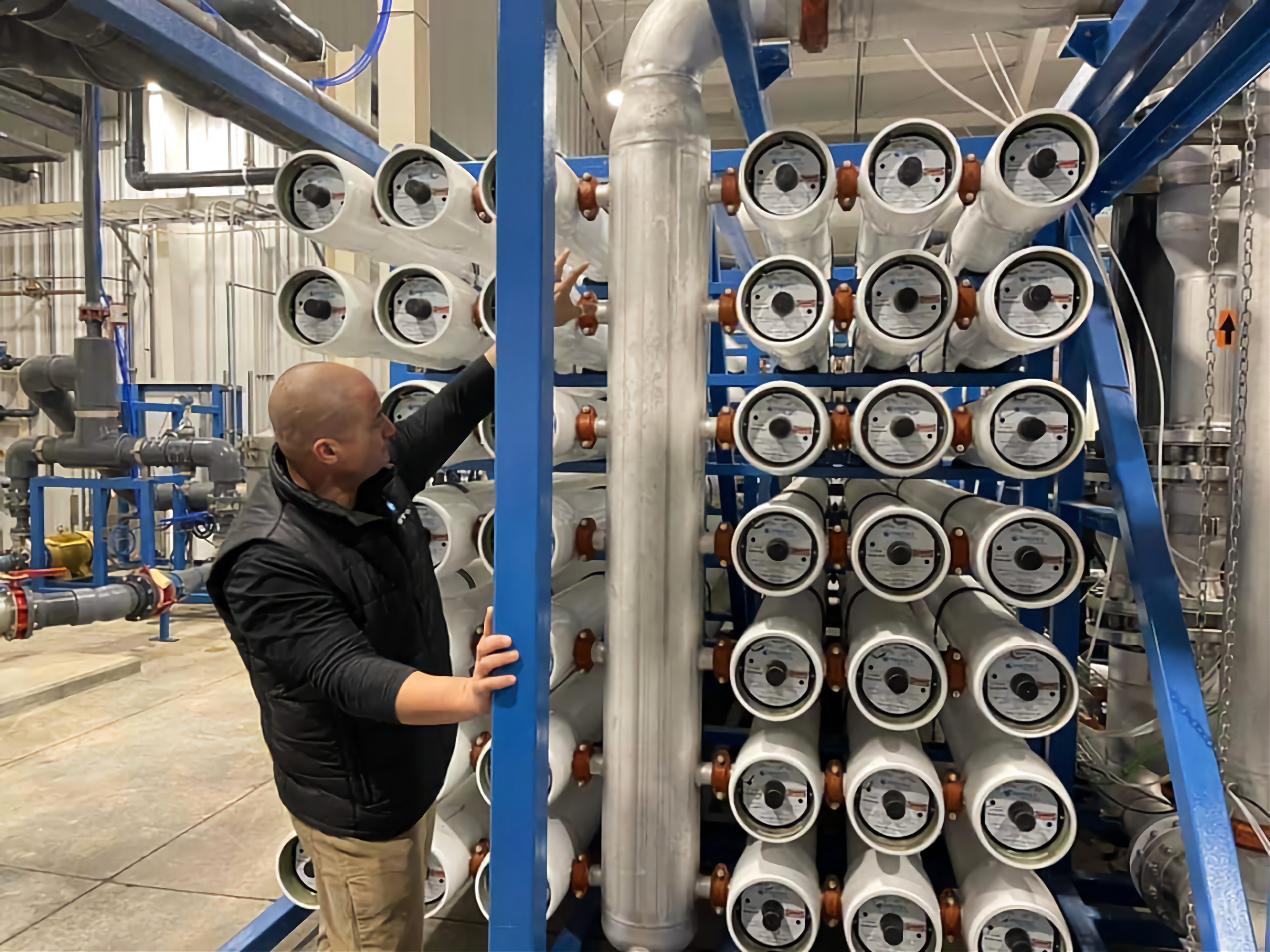Rural water utilities say they may not have the money to comply with new drinking water standards on per-and polyfluoroalkyl substances, also known as PFAS, and are warning that consumers may get stuck with the bill.
Clean water advocates celebrated the milestone announcement last week that the EPA was finalizing a strict rule limiting PFAS in drinking water. Under the new standards, public water systems must monitor and potentially take action to reduce levels of five individual PFAS or any combination of the chemicals.
Only 11 states have set enforceable drinking water standards for PFAS, a family of chemicals created for non-stick and waterproof products. Studies have linked PFAS, also known as “forever chemicals,” to cancer, reproductive issues and increased cholesterol.
The rule sets the first nationwide standard on the chemicals, which public health and environmental groups called a historic step in protecting all Americans. EPA estimates the rule will lower PFAS exposure for 100 million people, and greatly reduce cases of serious illness and deaths.
The next step is finding the money to meet the new standards. While the Biden administration has made additional funds available, water systems say it’s not enough.
“We’re seeing a real thirst for public health protection here,” said attorney Rob Bilott in a press call. “What’s going to be really important moving forward is making sure that the costs of implementing all of this are actually able to be absorbed by the folks, and that it doesn’t get passed on to the victims of this contamination.”
Bilott has led class action lawsuits against major chemical companies like DuPont. His story served as the inspiration for the 2019 motion picture “Dark Waters,” starring Mark Ruffalo.
EPA estimates between 6% and 10% of the 66,000 public drinking water systems subject to the standard will need to reduce PFAS levels.
But that number could be “substantially” higher, said Charles Stephens, National Rural Water Association senior executive policy director. Additionally, EPA’s estimate reflects a national average, which Stephens said “sanitizes” the reality for regions with generally higher levels of PFAS.
“The majority of the small rural systems are really on shoestring budgets,” Stephens said. “Very few," he said, "would have the funding available to be able to do this.”
Across the country, some water systems have already taken steps to reduce PFAS.
In 2019, West Morgan-East Lawrence Water and Sewer Authority in Alabama won a lawsuit against chemical company 3M which helped the system install a reverse osmosis treatment facility to eliminate PFAS found in drinking water.
 Inside a reverse osmosis treatment facility at West Morgan-East Lawrence Water and Sewer Authority in Alabama.
Inside a reverse osmosis treatment facility at West Morgan-East Lawrence Water and Sewer Authority in Alabama.“We know what's coming for these water authorities,” said Jeaniece Slater, general manager of the water authority. “Obviously the primary objective is public safety and awareness for our customers and other customers across the country. But the problem is going to be cost burden.”
The upfront costs for these technologies can be significant, but utilities also need to handle the additional costs of running and maintaining these machines. For Slater’s facility, the technology cost $32 million to build, and has increased electricity costs from about $40,000 a month to $100,000.
The funding from the lawsuit and money from the state revolving fund has helped shield consumers from the additional costs. Still, Slater said she is concerned there won’t be enough money for other water utilities to meet these standards, and believes other systems will similarly go after polluters to get the necessary funds.
EPA estimates the rule will cost $1.5 billion annually, and the Biden administration has made $1 billion in funding available from the bipartisan infrastructure law, which is part of a $9 billion investment from the infrastructure law to aid communities with drinking water contaminated by PFAS. The infrastructure law allocates an additional $12 billion for general drinking water improvements, which include addressing PFAS.
It’s easy to be “in the know” about what’s happening in Washington, D.C. Sign up for a FREE month of Agri-Pulse news! Simply click here.
However, water system groups have argued the bill will be much higher, and utilities will need more funds. A study cited by the American Water Works Association in its comments puts the upfront costs at $40 billion and up to $3.8 billion per year.
“The best way to keep our drinking water free from PFAS is to protect our precious source waters,” the group wrote in a statement. “AWWA continues to encourage EPA to follow through on its commitments to address harmful PFAS manufacturing, uses, and releases to the environment. Doing so appropriately requires polluters – not communities – to be held responsible for PFAS contamination.”
There are additional concerns about how much money actually will get to rural communities. They will be distributed through the Drinking Water State Revolving Fund to implement PFAS monitoring and treatment at public facilities, and in private wells.
However, allocations under the state revolving fund are based on a formula and may not be targeted to the areas with the most need, Stephens said. Rural communities have also struggled to apply, qualify and access other infrastructure dollars through the revolving fund, he added.
EPA received thousands of comments on the proposed rule, including several from NRWA and other water system representatives. Stephens said he was pleased to see some of their suggestions included in the final rule, such as a five-year implementation period instead of three. The final rule also allows some flexibility and community decision-making in implementing a solution to lower PFAS levels.
However, rural water systems are still uniquely challenged, Stephens said. The cheapest way to reduce PFAS levels is to find another water source, but that is not a viable option in most rural areas.
Instead, rural water systems that discover PFAS levels above the standard will likely have to implement technologies like activated carbon, reverse osmosis and ion exchange systems.
The new rule comes as water systems are dealing with other regulations, such as EPA’s lead and copper rule, and increased concerns over cybersecurity. Throughout the monitoring and implementation for the PFAS standards, systems may require new expertise, which can strain the existing labor shortage in the water sector.
For rural systems that already lack economies of scale or additional revenue opportunities, adding PFAS to these other challenges will be a significant drain on resources, Stephens said.
As a result of the additional costs, ratepayers may see an increase in their utilities, which could be a major burden for rural systems that serve communities already below the poverty line.
“I think legal challenges to this rule are inevitable,” said attorney Anna Wildeman, a former Trump administration official in EPA’s Office of Water.
EPA's cost-benefit analysis will likely be a basis for some of these challenges, but there could also be arguments against how the rule is structured, Wildeman said. The rule includes a novel hazard index approach, which Wildeman said there’s no strong basis for in any EPA regulatory programs.
“That is potentially precedent-setting, and would provide a pretty good hook to argue that the rule is either unlawful, exceeds the agency’s authority or is arbitrary,” Wildeman said.
Additionally, there could be technical disagreements and “battles of the expert” over some of the data EPA relied on in its rulemaking, she continued.
Already, chemical advocates are questioning the science used in the rule and arguing the levels are based on out-of-date research and will cost more than EPA projects.
“We strongly support the establishment of a science-based drinking water standard, but this rushed, unscientific approach is unacceptable when it comes to an issue as important as access to safe drinking water,” the American Chemistry Council wrote in a statement. “We strongly oppose this rule and will be working with the broad range of concerned stakeholders to determine next steps.”
Clean water advocates who have long pushed for stronger PFAS regulation argue these chemicals have caused billions of dollars in health care and treatment costs. The latest rule is a cost-efficient way of reducing dangerous contamination, said Scott Faber, senior vice president of government affairs at Environmental Working Group.
During press calls on the regulation, EPA officials, representatives from EWG and Bilott also suggested class-action settlements with PFAS manufacturers 3M, DuPont and others could offer funding to support utility compliance.
Through these settlements, over $13.5 billion are on the table for water systems, Bilott said.
Some existing programs under USDA Rural Development are also available to assist rural communities treating or mitigating issues including PFAS contamination, including the Water and Waste Disposal Loan and Grant Program and Loan Guarantees.
“Rural Development’s programs have always been available to assist rural communities make improvements to treat or mitigate problems, including PFAS impact,” said Andrew Berke, USDA Rural Development Rural Utilities Service administrator, in an email.
Rural communities with water systems that are impacted by PFAS or can show the potential of being impacted within a year are eligible to apply to the Emergency Community Water Assistance Grants Program, Berke said in an email. The program supports developing new water sources or upgrading treatment and offers up to $1 million to alleviate source water emergencies and up to $150,000 for distribution emergencies.
“The real costs that we should be focused on here are not the costs to water utilities, but the costs to people who have been getting cancer,” Faber said in a press call. “Or the costs to people who are suffering from cardiovascular disease because of the PFAS that’s building up in their blood.”
Steve Davies contributed to this report.
For more news, go to www.Agri-Pulse.com

